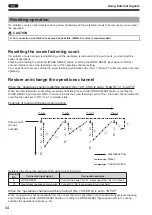
51
EN
Symptoms
Location to investigate
Solution
Input signal does not
react
Is there a mistake or error in cabling, or a
disconnection?
Is 0 V DC connected to the input signal
negative common wire (terminal No.10)?
Check the wiring. (p. 35)
Is the input signal (switch or PLC output
signal) firmly set to ON?
Check the external input signal.device being used.
Does the product setting and state match the
conditions receiving the input conditions?
Check each type of setting or state, and input a
signal at the suitable timing.
The output signal is
not output
Is there a mistake or error in cabling, or a
disconnection?
Is +24 V DC connected to the output signal
positive common wire (terminal No.22)?
Check the wiring. (p. 35)
Does the output signal specifications
(output circuit or output time, etc.) match
the input device or load specifications
detecting the output signal (input circuit or
reaction speed)?
Check the connecting external device or load.
Is the load in excess of the output signal
rating (30 V DC, 30mA), or the capacitive
load or inductive load, connected?
Since the output terminal (built-in photocoupler)
has the possibility of breaking down, do not
perform its connection.
When you want to use
a 2-wire sensor
A 2-wire sensor cannot be used.
I want to connect
with the NPN signal
method machine
The signal method is PNP.
Use the signal converter, etc., to perform connection.
The service power
24 V DC
cannot be extracted
Is there a mistake or error in cabling, or a
disconnection?
Check the wiring. (p. 35)
Hast the output current capacity (200mA)
been exceeded for use?
Do not exceed the output current capacity for use.
If the output current capacity is not sufficient, use
a separate external power source.
Buzzer sound is small
Is the buzzer sound setting too small?
Set the “buzzer sound volume” (No.22 BZ-
VOLUME) larger.
If the sound is still too small, attach a buzzer or
lamp to the output signal. (p. 34)
LCD display is difficult
to read
Is the back light (yellow-green color)
lighted up?
Set the “back light” (No.24 BACK LIGHT) to “ON”.
The electric
screwdriver gets hot
Is the ON (rotation) time of the electric
screwdriver too long?
Or is the OFF time too short?
Review the operation time.
The rated operating time is 0.5 sec. ON/3.5 sec.
OFF.
Aim at 15 screws or less for the screw tightening
per minute. (p. 8)
Is the tapping screw tightened?
If the load is high during tapping screws and
other screw tightening, the electric screwdriver
temperature will also tend to become higher.
Review the operations time, and lengthen the
OFF (stop) time.
Is the rated voltage input?
Check the power source voltage, and input the
rated voltage.
Does it become so hot that it cannot be
touched?
If so much heat is generated as to be too hot
to touch, even if the screw fastening load is not
heavy, and the rated operation time is maintained,
a failure is suspected.
Cannot be extracted
from the setting mode
Is the “operations channel switching
method” (No.1 CH-CHG) set to “S-AUTO” or
“C-AUTO”, and the “count function” (No.11
COUNT-FNC) set to all channels “OFF”?
Set any of the channel “count function” (No.11
COUNT-FNC) to “ON”. (p. 31)
An error message is
displayed on the LCD
Check the error message (p. 47), and re-insert the power.
The setting conditions
are unknown
It does not activate as
expected
Did you make a note of the settings?
Review each of the settings. (p. 25)
To initialize the setting values, execute “setting
value initialization” (No.25 SETTING RESET).
(p. 24)
After the setting, write down the settings on the
setting memo. (p. 63)
TV07783-1_DLV10C_en.indb 51
2017/06/27 17:41:42













































